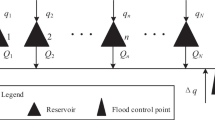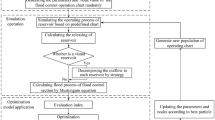Abstract
Alleviating flood stress and reducing flood disaster losses are vital issues when operating flood control systems. To address catastrophic floods, this study establishes an optimal flood control operation model for minimizing the excess flood volume of downstream flood control points. A triple-stage operation method (TSOM) is proposed to solve the model by dividing flood control operation processes into three stages. The constructed model is applied to the operation of a flood control system located in the middle and lower reaches of the Ganjiang River, China. The results demonstrate that the TSOM has superiority in solving efficiency, reducing excess flood volume by more than 30–230 million cubic meters compared with the progressive optimality algorithm (POA) for most designed floods with 500-year return periods. Furthermore, the discharge and water level processes created by the TSOM fluctuate less than those created by the POA, which meets the requirements of practical flood control operations.





Similar content being viewed by others
Data availability
Data are available after request from the corresponding author.
References
Afshar MH (2013) Extension of the constrained particle swarm optimization algorithm to optimal operation of multi-reservoirs system. Int J Electr Power Energy Syst 51:71–81. https://doi.org/10.1016/j.ijepes.2013.02.035
Ahmadi M, Bozorg-Haddad O, Marino MA (2014) Extraction of Flexible Multi-Objective Real-Time Reservoir Operation Rules. Water Resour Manag 28:131–147. https://doi.org/10.1007/s11269-013-0476-z
Barredo JI (2007) Major flood disasters in Europe: 1950–2005. Nat Hazard 42:125–148. https://doi.org/10.1007/s11069-006-9065-2
Chen J (2014) An approach on flood control strategy in middle and lower reaches of Yangtze River after the completion of the Three Gorges Dam project. Adv Water Sci 25:745–751 (in Chinese)
Chen S, Li D, Tao X, Huang Y (2017) Development and application of a compensative regulation linear programming model for reservoir flood-control. Adv Water Sci 28:507–514 (in Chinese)
Cheng CT, Shen JJ, Wu XY, Chau KW (2012) Operation challenges for fast-growing China’s hydropower systems and respondence to energy saving and emission reduction. Renew Sustain Energy Rev 16:2386–2393. https://doi.org/10.1016/j.rser.2012.01.056
Cheng CT, Wang S, Chau KW, Wu XY (2014) Parallel discrete differential dynamic programming for multireservoir operation. Environ Modell Softw 57:152–164. https://doi.org/10.1016/j.envsoft.2014.02.018
Chou FNF, Wu CW (2015) Stage-wise optimizing operating rules for flood control in a multi-purpose reservoir. J Hydrol 521:245–260. https://doi.org/10.1016/j.jhydrol.2014.11.073
Comprehensive Planning of Ganjiang River Basin (2015) Changjiang water resources commission of the ministry of water resources. Comprehensive Planning of Ganjiang River Basin Wuhan, China (in Chinese)
Fu X, Mei YD, Xiao ZH (2016) Assessing flood risk using reservoir flood control rules. J Earth Sci 27:68–73. https://doi.org/10.1007/s12583-016-0615-6
Gill MA (1978) Flood routing by the Muskingum method. J Hydrol 36:353–363. https://doi.org/10.1016/0022-1694(78)90153-1
Gong Y, Liu P, Cheng L, Chen GY, Zhou YL, Zhang XQ, Xu WF (2020) Determining dynamic water level control boundaries for a multi-reservoir system during flood seasons with considering channel storage. J Flood Risk Manag 13:17. https://doi.org/10.1111/jfr3.12586
Guo SL, Chen JH, Li Y, Liu P, Li TY (2011) Joint Operation of the Multi-Reservoir System of the Three Gorges and the Qingjiang Cascade Reservoirs. Energies 4:1036–1050. https://doi.org/10.3390/en4071036
Hejazi MI, Cai X, Ruddell BL (2008) The role of hydrologic information in reservoir operation - Learning from historical releases. Adv Water Resour 31:1636–1650. https://doi.org/10.1016/j.advwatres.2008.07.013
Holland JH (1992) Genetic Algorithms. Sci Am 267:66–72. https://doi.org/10.1038/scientificamerican0792-66
Howson HR, Sancho NGF (1975) A new algorithm for the solution of multi-state dynamic programming problems. Math Program 8:104–116. https://doi.org/10.1007/BF01580431
Hui R, Lund JR (2015) Flood Storage Allocation Rules for Parallel Reservoirs. J Water Res Plan Man 141:13. https://doi.org/10.1061/(asce)wr.1943-5452.0000469
Karamouz M, Houck MH (1982) Annual and monthly reservoir operating rules generated by deterministic optimization. Water Resour Res 18:1337–1344. https://doi.org/10.1029/WR018i005p01337
Kim YG, Jo MB, Kim P, Oh SN, Paek CH, So SR (2021) Effective Optimization-Simulation Model for Flood Control of Cascade Barrage Network. Water Resour Manag 35:135–157. https://doi.org/10.1007/s11269-020-02715-0
Labadie JW (2004) Optimal operation of multireservoir systems: State-of-the-art review. J Water Res Plan Man 130:93–111. https://doi.org/10.1061/(asce)0733-9496(2004)130:2(93)
Li JY, Zhong PA, Yang MZ, Zhu FL, Chen J, Xu B, Liu WF (2019) Dynamic and Intelligent Modeling Methods for Joint Operation of a Flood Control System. J Water Res Plan Man. https://doi.org/10.1061/(asce)wr.1943-5452.0001110
Malekmohammadi B, Zahraie B, Kerachian R (2010) A real-time operation optimization model for flood management in river-reservoir systems. Nat Hazard 53:459–482. https://doi.org/10.1007/s11069-009-9442-8
Needham JT, Watkins DW, Lund JR, Nanda SK (2000) Linear programming for flood control in the Iowa and Des Moines rivers. J Water Res Plan Man 126:118–127. https://doi.org/10.1061/(asce)0733-9496(2000)126:3(118)
Saadat M, Asghari K (2019) Feasibility Improved Stochastic Dynamic Programming for Optimization of Reservoir Operation. Water Resour Manag 33:3485–3498. https://doi.org/10.1007/s11269-019-02315-7
Tan QF, Wang X, Liu P, Lei XH, Cai SY, Wang H, Ji Y (2017) The Dynamic Control Bound of Flood Limited Water Level Considering Capacity Compensation Regulation and Flood Spatial Pattern Uncertainty. Water Resour Manag 31:143–158. https://doi.org/10.1007/s11269-016-1515-3
Wang QS, Zhou JZ, Dai L, Huang KD, Zha G (2021) Risk assessment of multireservoir joint flood control system under multiple uncertainties. J Flood Risk Manag 14:e12740. https://doi.org/10.1111/jfr3.12740
Yang G, Guo S, Liu P, Li L, Xu C (2017) Multiobjective reservoir operating rules based on cascade reservoir input variable selection method. Water Resour Res 53:3446–3463. https://doi.org/10.1002/2016wr020301
Yang TT, Gao XG, Sorooshian S, Li X (2016) Simulating California reservoir operation using the classification and regression-tree algorithm combined with a shuffled cross-validation scheme. Water Resour Res 52:1626–1651. https://doi.org/10.1002/2015WR017394
Zhang JW, Li ZJ, Wang X, Lei XH, Liu P, Feng MY, Khu S-T, Wang H (2019a) A novel method for deriving reservoir operating rules based on flood classification-aggregation-decomposition. J Hydrol 568:722–734. https://doi.org/10.1016/j.jhydrol.2018.10.032
Zhang SH, Jing Z, Li WD, Yi YJ, Zhao Y (2018) Study of the flood control scheduling scheme for the Three Gorges Reservoir in a catastrophic flood. Hydrol Process 32:1625–1634. https://doi.org/10.1002/hyp.11515
Zhang W, Liu P, Chen XZ, Wang L, Ai XS, Feng MY, Liu DD, Liu YY (2016) Optimal Operation ofMulti-reservoir Systems Considering Time-lags of Flood Routing. Water Resour Manag 30:523–540. https://doi.org/10.1007/s11269-015-1175-8
Zhang W, Liu P, Wang H, Lei XH, Feng MY (2017) Operating rules of irrigation reservoir under climate change and its application for the Dongwushi Reservoir in China. J Hydro-Environ Res 16:34–44. https://doi.org/10.1016/j.jher.2017.05.003
Zhang X, Liu P, Xu C-Y, Gong Y, Cheng L, He S (2019b) Real-time reservoir flood control operation for cascade reservoirs using a two-stage flood risk analysis method. J Hydrol. https://doi.org/10.1016/j.jhydrol.2019.123954
Zhang X, Luo JG, Sun XM, Xie JC (2019c) Optimal reservoir flood operation using a decomposition-based multi-objective evolutionary algorithm. Eng Optimiz 51:42–62. https://doi.org/10.1080/0305215X.2018.1439942
Zhou YL, Guo SL, Liu P, Xu CY, Zhao XF (2016) Derivation of water and power operating rules for multi-reservoirs. Hydrolog Sci J 61:359–370. https://doi.org/10.1080/02626667.2015.1035656
Zhu D, Mei Y, Xu X, Chen J, Ben Y (2020) Optimal operation of complex flood control system composed of cascade reservoirs, navigation-power junctions, and flood storage areas. Water 12:1883. https://doi.org/10.3390/w12071883
Zhu D, Mei YD, Xu XF, Liu ZJ, Wu ZH, Cai H (2021) Optimal Operation of a Parallel Multireservoir System for Flood Control using a Stagewise Compensation Method. Water Resour Manag 35:1689–1710. https://doi.org/10.1007/s11269-021-02803-9
Funding
This study was financially supported by the National Key Research and Development Program of China (No. 2021YFC3200303), the Research Council of Norway (FRINATEK Project 274310) and the National Key Research and Development Program (No. 2018YFC0407904).
Author information
Authors and Affiliations
Contributions
The first author wrote the draft manuscript and the other authors reviewed and improved the manuscript several times.
Corresponding author
Ethics declarations
Ethical Approval
The authors declare that they have no conflict of interest.
Consent to Participate
The authors declare that they are aware and consent with their participation on this paper.
Consent to Publish
The authors declare that they are consent with the publication of this paper.
Competing Interests
There is not any competing interest.
Additional information
Publisher's Note
Springer Nature remains neutral with regard to jurisdictional claims in published maps and institutional affiliations.
Appendix
Appendix
Rights and permissions
Springer Nature or its licensor holds exclusive rights to this article under a publishing agreement with the author(s) or other rightsholder(s); author self-archiving of the accepted manuscript version of this article is solely governed by the terms of such publishing agreement and applicable law.
About this article
Cite this article
Zhu, D., Chen, H., Zhou, Y. et al. A Triple-stage Operation Method for Deriving Operation Rules for Cascade Reservoirs during Catastrophic Flood Events. Water Resour Manage 36, 4863–4883 (2022). https://doi.org/10.1007/s11269-022-03189-y
Received:
Accepted:
Published:
Issue Date:
DOI: https://doi.org/10.1007/s11269-022-03189-y








